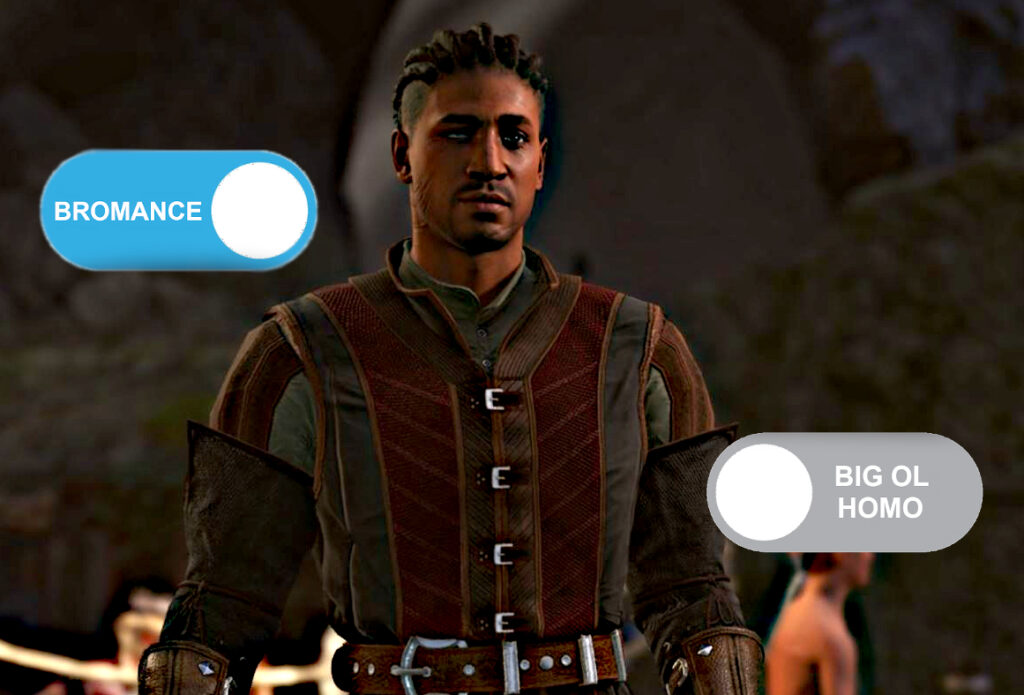
No Straight Boys, We Do Not Need a Bromance Toggle in Video Games
Ah, the bromance toggle… That ol’ chestnut.
You’ll be forgiven for never having heard of the bromance toggle before. It’s not exactly a new phenomenon among straight gamers, and has been often asked for every single time a non-straight character exists alongside the typically hypermasculine protagonist. But it’s still very rare for a straight gamer to do the mental gymnastics of ‘man, I really don’t like it when this guy character hits on me, can’t we just shut that off somehow?’ and then post about it online. You’ll usually then find the same person arguing about censorship in video games, mostly when it comes to fictional characters butts.
Despite it being pretty unsubtle homophobia, bromance toggles don’t get as much flack as they deserve in community spaces. I suspect it’s because, in some fashion, the toggle acts as a way for people to say ‘look, it’s just giving people a choice.’ But that choice doesn’t exist in a vacuum, it has layers to it. To shut off a man’s interest in other men just because it makes you, the player, uncomfortable. Well, you might as well turn around and say we aren’t worth having around unless we can fit into the heteronormative society you’ve grown up in, in a video game. Even if it means us trying to squeeze in a shoe that’s two sizes too small.
To me, not only is that insane but it completely negates the joy of video games in general. One of the most exciting things about video games is how they allow us to embrace both the smallest and largest parts of ourselves – whether that’s something as huge as gender identity, or something as small as realizing ‘eh, vampire ladies don’t do it for me.’
But what gets me about the bromance toggle is that, ultimately, if a community is calling for it in the first place then you’ve failed in creating a character whose attraction to men is part of who they are. If their desire can be ignored in the first place, if it adds nothing, then why is it there? For example, let’s look at Baldur’s Gate 3 and the playersexuality it affords to its companions. Playersexuality isn’t exactly our favourite way of handling sexuality in video games, but we appreciate that it gives people more choice to pick who they like the best.
However, from the companions we have so far anyway, none of the companions – minus Astarion – imply that they like both people of the opposite and same-sex. Wyll and Gale even have old love interests, both of whom are female, that they show some sort of lingering attachment to – which isn’t necessarily bad. It certainly doesn’t negate their attraction to male players, but the problem is that there is no inkling or portrayal of same-sex desire until you initiate it, or you get to a certain part of the story where that character hits on you, regardless if you’ve talked to them before. For Baldur’s Gate 3, a game that boasts itself of doing things differently from BioWare in terms of romance, it isn’t the best of looks. That said, the game is still in early access and its handling of sexuality could change. We certainly hope so.
There will always be someone who flinches at a selection of pixels flirting with them because they present in a way that upsets their heterosexual sensibilities, that’s why people ask for the bromance toggle in the first place. Yet the desire for this toggle in the first place should make you second guess how you’re presenting the sexuality of your characters in the first place – is it something that’s a part of them, or is it, if you really did have a toggle, something that would never come up in the first place? If it’s the latter, then perhaps the way the character’s sexuality is attributed is just bad in the first place.
Just a thought.





